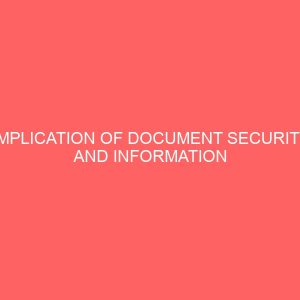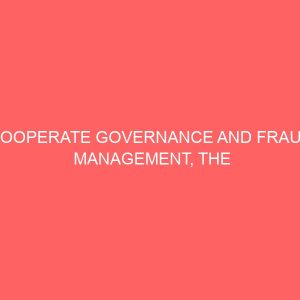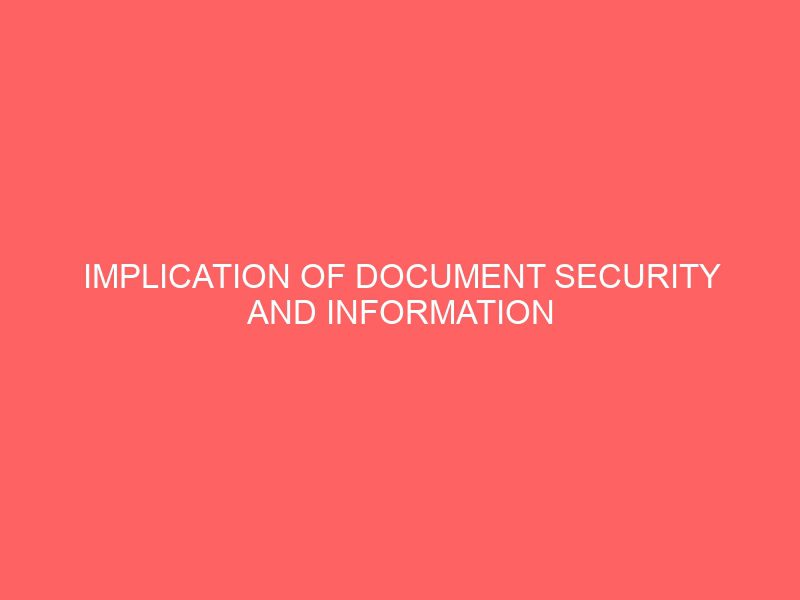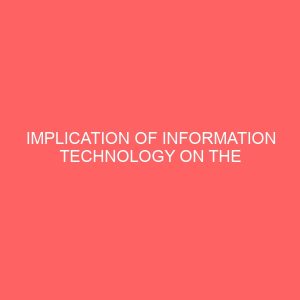Description
THIS RESEARCH WORK IS ON IMPLICATION OF DOCUMENT SECURITY AND INFORMATION RESOURCE MANAGEMENT ON THE ACCOUNTING SYSTEM IN NIGERIA
CHAPTER ONE
1.1 INTRODUCTION
BACKGROUND OF STUDY
Document in it’s fullest meaning implies any material which contains “hark” symbols or signs either visible, partially visible or invisible that may be presently or ultimately convey a meaning or message to someone or a system: pencil or ink writing, writing or printing on paper is the most usual form.
Like writing the origin (history) of document is not quite clear and certain, but the history of document is as old as human race. Document security is the physical protection involving the guiding of documents and classified papers from loss, unauthorized person, damage, pilferage, theft and compromise through disclosures. Safeguarding vital records (documents inclusive) is one of the most difficult tasks that can be assigned to any employee of a particular organization.
Classified documents needs special and concerned handling. Lack of indoctrination and orientation among personnel handling these document(s) can result in loss, pilferage, leakage, theft and unauthorized disclosure of document. There is no Nation, society, community or organization today that can boost of engaging in business transactions, personal or group oriented undertakings without the use of document. Document is the blood stream of business activities when this is absent intra as well as inter group communication will be hampered and business life will be completely disrupted.
INFORMATION RESOURCE MANAGEMENT
Every document contains information. A business greatest resource is information and it is essential not only in modern living, but also in the administration and exception of most activities, in every enterprises, information basically help to assist it’s recipients in the execution of task hence Management of information is vital.
To perform, it’s satisfactorily necessitate an understanding of information and all the consideration comprising the activities of information administration. Information is needed primarily for two major reasons viz:
· To serve as discipline
· To provide the basis for decisions
Information can be classified into:
a) Repetive information: These are generated at intervals of not less than one year e.g. inventory information.
b) Non‑repetive information: These are special studies made to assist managers.
c) Operational information: it is the information employed by Operational Managers to plan and carry out daily operations of the
business.
d) Compulsory information: It is that information required by the Government and other external agencies including audit firms and insurance companies e.g. annual financial statements: Accountant’s Reports “letter of pre‑merger consent” etc.
e) Active information: requires it’s recipient’s to take actions.
f) Passive information: information that does not require it’s recipients to take actions.
g) Past and future information: Planning requires future information and projections based on past information.
ATTRIBUTE OF INFORMATION
A classic study in the 1950’s by Simon et al, identified three attributes of accounting information as follows
i) It should be useful for score keeping, seeing how well the organization is doing overall.
ii) It should be useful for attention ‑ directing; indicating problem that need to be investigated.
iii. It should be useful for problem solving a means of evaluating alternative responses to the situation in which the organization find itself.
1.2 STATEMENT OF PROBLEMS
There is no Nation, society, community or organization today that can boast of engaging in business transactions, personal or group oriented undertakings without the use of documents. Documents are the blood stream of business activities. When this is absent
1.4 RESEARCH QUESTIONS
1) How are information managed?
2) What are the causes and effects of fraud and forgeries and evidential signature an accounting system?
3) How can fraud be prevented using document security?
4) What arc the steps involved in document security/ examination and detection of fraud and forgeries?
5) What are the possible ways in which document can be forged?
1.5 RESEARCH HYPOTHESIS
i. Ho ‑ Null Hypothesis: There are no effects of internal control on accounting system and document security
Hi ‑ Alternate Hypothesis: The accounting system are affected by document security.
ii. Ho ‑ Null Hypothesis: Fraud cannot be prevented and detected in an organization.
Hi: Alternate hypothesis: Fraud can be prevented and detected in an organisation.
iii. Ho ‑ Null Hypothesis: There are no benefits accruable to organisation for securing document, and managing information resource.
1.8 DEFINITION OF TERMS
1) Forgery: this refers to falsification. of documents and or signature.
2) Transactions: This involves buying and selling and other related business activities.
3) Graphology: this implies the assessment of personality traits from a person handwriting. It also means the study of handwriting.
4) Transmitting: to disseminate, give or send out data.
5) Inventory: this is the stock of materials or component which an organisation uses in the manufacturing process.








Reviews
There are no reviews yet.